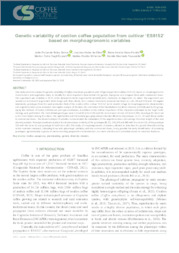Genetic variability of conilon coffee population from cultivar 'ES8152' based on morphoagronomic variables.
Genetic variability of conilon coffee population from cultivar 'ES8152' based on morphoagronomic variables.
Author(s): SENRA, J. F. B.; SILVA, J. A. da; FERRAO, M. A. G.; ESPOSTI, M. D. D.; MILHEIROS, I. S.; FASSARELLA, K. M.
Summary: This study aimed to analyze the genetic variability of Coffea canephora population with 190 genotypes from cultivar ?ES8152?, based on morphoagronomic characteristics and vegetation index, to identify the most important characteristics for genetic divergence and compare them with commercial clones. The experiment was installed, in 2019, at the Bananal do Norte Experimental Farm/INCAPER, Cachoeiro de Itapemirim, ES, Brazil. The experiment was carried out in Federer?s augmented block design with three blocks, four common treatments (commercial clones A1, LB1, V8 and V12) and 190 regular treatments, genotypes from the seed production field of the conilon coffee cultivar ?ES8152?. At 24 months of age 14 morphoagronomic characteristics and vegetation index were evaluated. Descriptive analysis of the data, the estimation of the Standardized Euclidean Distance (ED) followed by the grouping by the methods of Tocher, UPGMA and principal coordinates, in addition to the relative importance of the characters estimated by the Singh methodology were performed. The most distant genotypes were 62 and 83 (ED=2.620) and the closest were 42 and 160 (ED=0.208). Genotype 83 stood out as the most distant among the others. The optimization and hierarchical groupings allowed the identification of genotypes 15, 81, 107 and 184 as similar to commercial clones. The discard analysis of variables recommended the elimination of the vegetation index and average internode length of the next diversity analysis. Principal coordinate analysis found phenotypic similarity of the genotypes 30, 81, 115, 141 and 163 with the clone V12, of the genotype 119 with the clone A1 and genotype 17 with clone LB1. The study, of morphoagronomic characters, allowed to detection the genetic diversity existing in the materials evaluated, indicating those with phenotypic similarity with the commercial clones, being possible the early identification of promising genotypes, agronomically superior, to start a breeding program for clonal selection, recurrent selection and controlled crosses to maximize heterosis.
Publication year: 2022
Types of publication: Journal article
Unit: Embrapa Coffee
Observation
Some of Embrapa's publications are published as ePub files. To read them, use or download one of the following free software options to your computer or mobile device. Android: Google Play Books; IOS: iBooks; Windows and Linux: Calibre.
Access other publications
Access the Agricultural Research Database (BDPA) to consult Embrapa's full library collection and records.
Visit Embrapa Bookstore to purchase books and other publications sold by Embrapa.

